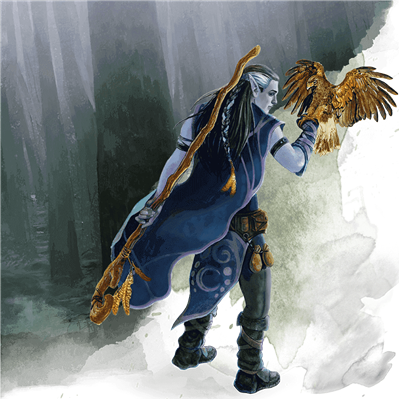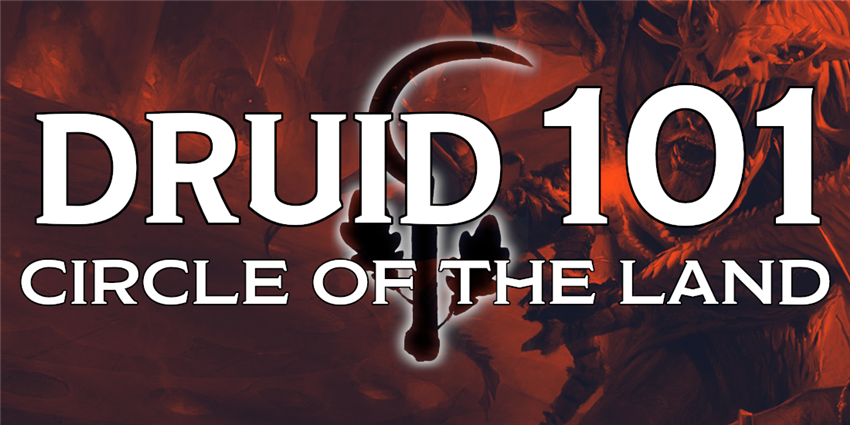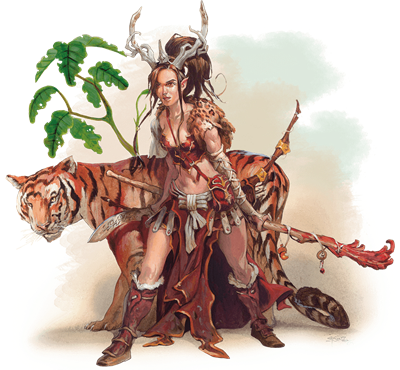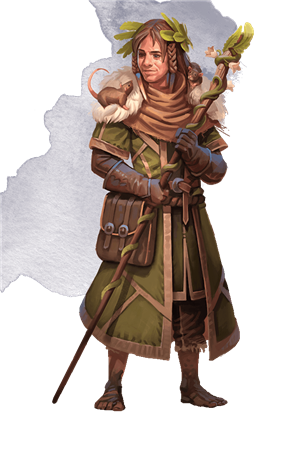 Class is in session, and today we turn to the mystical druidic Circle of the Land. Druids are mystics dedicated to upholding the balance of nature, and indeed the balance of the world itself. A druid’s innate connection with the natural world grants them the power to transform into animals, speak with flora and fauna, and even command the weather itself to strike down nature’s foes. As a druid of the land, you are particularly attuned to the magic of the world.
Class is in session, and today we turn to the mystical druidic Circle of the Land. Druids are mystics dedicated to upholding the balance of nature, and indeed the balance of the world itself. A druid’s innate connection with the natural world grants them the power to transform into animals, speak with flora and fauna, and even command the weather itself to strike down nature’s foes. As a druid of the land, you are particularly attuned to the magic of the world.
Story of the Circle of the Land
“Fear not,” the druid said, stroking his long, gray beard. “The wolves will heed my words, and harry you no longer.”
The group of astonished adventurers instinctively parted to let the druid pass. The party rogue turned to his companions and hissed, “How can you let that crazy old man walk to his death like that? Look at that staff he’s using; he can hardly walk, let alone fight off a pack of wolves!”
The ranger affixed her ally with a stern look, and replied simply. “Trust him. My grandfather is the master of this wood—all those in this domain will heed his words.” The rogue sneered, but said nothing. Instead, he took a step forward to get a better look as the wizened old man descended the rocky cliff towards the pack of snarling, silver-furred wolves below.
The druid planted his feet in the dirt and clacked the base of his gnarled yew staff against a stole. The wolves turned their golden eyes to him, and he met their eyes in turn. He opened his mouth and spoke in an even tone. His voice was smooth and placid like the surface of a pond, and the rogue strained to catch his words. “Children of the forest. Children of the land,” he said, staring unblinkingly into the eyes of the wolf pack’s leader. “Heed me. Those you hunt this day are under my protection. Their flesh is my flesh. To sink your fangs into them is to wound me, and to wound me is to wound yourselves. Go. Hunt elsewhere.”
The wolves snorted and barked, and the rogue smirked. This crazy old man, he thought. But as the rogue looked closer, the wolves began to turn, one by one, and vanish into the woods. The druid watched until all were gone, and then turned and looked over one shoulder, meeting the rogue’s gaze with his own golden, lupine eyes.
Druids who learn the ways of the Circle of the Land are deeply in touch with the magic of the land itself, and can feel magic flow like blood through the ley lines of the world, binding and uniting all living things. By studying this circle of druidic power, you expand the breadth of your magical knowledge and develop an unbreakable bond with the beasts and plants of the world, as well as spirits of nature, such as elementals and fey.
If this sort of story appeals to you, read on. From here, you will learn to create a druid that can harness the power of the land itself.

Circle of the Land Features
Druids of the Circle of the Land invest their power in spells, making them most similar to wizards, sorcerers, and other classes that put spellcasting first and foremost. One of their first subclass features, Natural Recovery, is even similar to the wizard’s own Arcane Recovery feature, allowing you to regain a certain amount of expended magical energy by taking a short rest.
Druids gain their Druid Circle at 2nd level, and gain subclass features at 2nd, 6th, 10th, and 14th level, in addition to additional spells every other level, up to 9th. You can read all of the Circle of the Land features for free in the D&D Basic Rules. In summary, your subclass features allow you to:
- Recover expended spell slots by completing a short rest, once per day
- Gain additional spells unique to the landscape in which you first became a druid
- Move through difficult terrain unimpeded, and resist magical effects that cause the land to rise against you
- Resist the charms and tricks of fey and elementals, and gain immunity to poison and disease
- Befriend the beasts and living plants of the world
Benefits of the Circle of the Land
 Playing a Circle of the Land druid puts your spellcasting abilities first and foremost. While other druid circles focus on melee combat in Wild Shape, this subclass allows you to cast spells as well as a cleric or a wizard while not sacrificing any of your class’s inherent flexibility. By focusing on spells, you allow yourself to play a well-balanced jack-of-all-trades—a suitable aspiration for a druid that seeks to maintain the balance of the natural world.
Playing a Circle of the Land druid puts your spellcasting abilities first and foremost. While other druid circles focus on melee combat in Wild Shape, this subclass allows you to cast spells as well as a cleric or a wizard while not sacrificing any of your class’s inherent flexibility. By focusing on spells, you allow yourself to play a well-balanced jack-of-all-trades—a suitable aspiration for a druid that seeks to maintain the balance of the natural world.
Your Circle Spells grant you some flexibility by granting you situational spells without them counting against your total prepared spells—though some circles grant you vital spells like lightning bolt, giving you the freedom to choose more situation spells yourself.
Finally, though your Wild Shape isn’t quite as powerful as the mighty Circle of the Moon druid’s, you can still use your Wild Shape for stealth, reconnaissance, and travel, further adding to your versatility.
Drawbacks of the Circle of the Land
The Circle of the Land’s greatest strength—its spells—are also its greatest weakness. If you don’t like playing characters that have to juggle a lot of spells or spellcasting options, this subclass is not for you. While all druids have spells, the Circle of the Land grants you greater control over your spells and is more demanding that you know how your manifold spells work in order to be an effective druid.
Likewise, by playing a more wizard-like spellcaster, you will find that you aren’t a particularly effective melee combatant. If you use your spells wisely and stay in the back rank of your party, this won’t be a problem—but you may be vulnerable to stealthy assassins and other foes that can slip through your party’s defenses and sink their blades into your squishy, lightly armored form.
Suggested Build
If you’re playing a Circle of the Land druid, you should choose a race that grants you a bonus to Wisdom, like a wood elf or hill dwarf. Both of these races already have a natural connection to the land itself, and thematically match the class, making them a perfect fit! Likewise, races with bonuses you can assign to any trait, such as a variant human or a half-elf, also allow you to allocate your ability score bonuses as you see fit, while also letting you get some other useful traits, too, like extra skill proficiencies. After Wisdom, consider what your second- and third-highest ability scores will be. Dexterity will improve your middling Armor Class, but Constitution will make you a more durable caster and more likely to avoid losing concentration of your valuable support spells.
As usual, your character’s background is up to you. Many druids come from a hermit or outlander background, and live in relative isolation in the wild places of the world. But not all druids are the same. Perhaps you were a street urchin who fled from the streets of Waterdeep and were saved by a druidic master and taken to the heart of the High Forest where you were trained in the druidic arts—or so on.
Selecting EQUIPMENT when building a 1st-level druid will make your life easier, as most druids don’t have to worry too much about what equipment they carry. Fortunately, your spell selection is more important to your continued survival than your equipment selection, so just choose whatever tools you think would be useful.
Spells
 Speaking of spells, let’s choose a spell selection for you at 1st level. You don’t choose your subclass until 2nd level, but you can still carve out your role in the party through your spell selection before you officially join the Circle of the Land. Like a cleric, you have your entire class spell list available to you whenever you prepare spells at the start of the day. Nevertheless, when playing a druid, I like to have a typical spell list that my druid always has prepared—unless I specifically choose otherwise. This saves me the trouble of having to re-select all my spells at the start of each day. Since you’ll be doing a little bit of everything as a spellcasting druid, having spells that run the gamut from offense to defense to support is vital. Fortunately, starting at 3rd level, you will have several spells automatically prepared thanks to your Circle Spells feature.
Speaking of spells, let’s choose a spell selection for you at 1st level. You don’t choose your subclass until 2nd level, but you can still carve out your role in the party through your spell selection before you officially join the Circle of the Land. Like a cleric, you have your entire class spell list available to you whenever you prepare spells at the start of the day. Nevertheless, when playing a druid, I like to have a typical spell list that my druid always has prepared—unless I specifically choose otherwise. This saves me the trouble of having to re-select all my spells at the start of each day. Since you’ll be doing a little bit of everything as a spellcasting druid, having spells that run the gamut from offense to defense to support is vital. Fortunately, starting at 3rd level, you will have several spells automatically prepared thanks to your Circle Spells feature.
As a 1st-level druid, you know two cantrips and can prepare a number of 1st-level spells equal to 1 + your Wisdom modifier. Odds are, your Wisdom modifier will be either +2 or +3 right now, so you’ll be able to choose either three or four 1st-level spells whenever you complete a long rest. Even as a support character, you’ll want to have at least one offensive cantrip; produce flame is a good choice, since it can serve as both offense and utility. Beyond this, your cantrips are simply a matter of preference, and almost any will serve you well. Druidcraft is another good first choice, since it lets you perform all manner of minor, “druid-y” tricks.
You can prepare any 1st-level spells from the druid spell list, but you can use this list of suggested spells to prepare an all-purpose spell loadout that will serve you in most circumstances. As you go on adventures and learn what dangers your character tends to face, you can personalize your spell loadout. Try to choose one spell labeled SUPPORT, one labeled DEFENSE, and one labeled OFFENSE or UTILITY. If you have a high Wisdom score and can prepare additional spells, choose others of your choice. Note that this list only includes some spells from the Player's Handbook, so if you want to choose more unusual spells, or have other sources like Xanathar's Guide to Everything, you'll have to do a little self-directed research. This list is just here to get you started if this is your first time playing a Circle of the Land druid.
Be warned that many druid spells require concentration, and you can only concentrate on one spell at once. Try to limit the number of concentration spells you prepare to no more than 1/3 of your spell loadout on any given adventuring day. To aid in this, all concentration spells on this list are listed as such.
- Animal Friendship (DEFENSE/UTILITY)
- Cure Wounds (SUPPORT)
- Entangle (DEFENSE; CONCENTRATION)
- Faerie Fire (SUPPORT; CONCENTRATION)
- Healing Word (SUPPORT)
- Speak with Animals (UTILITY)
- Thunderwave (OFFENSE)
At Higher Levels
As you gain druid levels, the Circle of the Land grants you greater and greater power, and further access to spells. You’ll want to continue balancing your spells between offense, defense, support, and utility, but also keep an eye on the composition of your party. If you don’t have a cleric in your party, consider adding more healing spells to your selection; healing spirit recently drummed up some controversy, but it’s an excellent healing spell for a druid to take once they reach 3rd level. Consider sending this article to your DM, if they protest your using this spell.
On the other hand, if you’re lacking offensive spellcasting, think about what you can do to fill that role. Druids don’t have a ton of offensive options, but spells like call lightning can be devastating if you’re outdoors, and lightning bolt is second only to fireball in terms of raw devastation. If you and your DM are willing to handle the challenge of summoning creatures, spells like conjure animals or conjure minor elementals will help your party out in combat in a major way. Just take a look at this article for advice on handling summoned creatures, and this article for advice on making the most of conjuring elementals.
If you want more advice for building a druid, check out Druid 101. Have you ever played a Circle of the Land druid? What advice would you give to players that want to make a character like this?
 James Haeck is the lead writer for D&D Beyond, the co-author of Waterdeep: Dragon Heist and the Critical Role Tal'Dorei Campaign Setting, the DM of Worlds Apart, and a freelance writer for Wizards of the Coast, the D&D Adventurers League, and Kobold Press. He lives in Seattle, Washington with his partner Hannah and their animal companions Mei and Marzipan. You can find him wasting time on Twitter at @jamesjhaeck.
James Haeck is the lead writer for D&D Beyond, the co-author of Waterdeep: Dragon Heist and the Critical Role Tal'Dorei Campaign Setting, the DM of Worlds Apart, and a freelance writer for Wizards of the Coast, the D&D Adventurers League, and Kobold Press. He lives in Seattle, Washington with his partner Hannah and their animal companions Mei and Marzipan. You can find him wasting time on Twitter at @jamesjhaeck.








-
View User Profile
-
Send Message
Posted Jun 7, 2019"As a 1st level cleric, you know 2 cantrips" copy and paste <.<
The first campaign my wife and i were in together we were both druids. She was Land, i was moon. Shes always been partial to casters, i just like being a big hitter.
-
View User Profile
-
Send Message
Posted Jun 7, 2019Great article with lots of good advice. Playing a Circle of the Land druid in a current campaign. Been a lot of fun so far. The setting is a group of islands, so I went for Circle of the Coast with a Sailor's background. Been focusing on wind/water/ice spells for the most part. But the group doesn't really have a healer, so I've been able to step into that role more and more. The versatility of the spells is really an asset, especially since the group has been splitting up quite a bit of late. Depending on what our mini-group is trying to accomplish, I'm able to tailor my spell selections accordingly. The downside, is that he is still pretty squishy at these low levels. In the last session, our stealth mission went horribly wrong and orcs swarmed us. My poor druid and his brother were captured. But luckily the orcs didn't see my druid wild shape. So I have a chance to get out of this mess... adjusting spell selection for maximum escape potential!
-
View User Profile
-
Send Message
Posted Jun 7, 2019My backup character is Circle of Land, Swamp. Because the party is currently on an island with a BAD BAD SWAMP PLACE and I figured if my main died, that's where it would be and I could step in. LOL I'll hold her in reserve as a new character if my ranger makes it through the campaign.
-
View User Profile
-
Send Message
Posted Jun 7, 2019Druids are a fairly good class all around, because they don't really have a "worst" subclass (as opposed to, say, barbarians or rangers). I would say that Circle of the Moon is probably the best, but if you really want to cast a lot of spells, Circle of the Land is fairly good.
Small typo, I think. In the first paragraph of the story, it says, "They wolves will heed by words..." Is that supposed to be "They will heed my words..."? It just doesn't sound quite right.
-
View User Profile
-
Send Message
Posted Jun 7, 2019Just boosting this so the author may see the possible typo.
-
View User Profile
-
Send Message
Posted Jun 8, 2019I don't see this typo? It reads as "The wolves will heed by words, and harry you no longer.”" to me.
-
View User Profile
-
Send Message
Posted Jun 8, 2019The only problem I have with non-Circle of the Moon druids is that their Wild Shape maxes out at CR 1 beasts when it should go up to CR 2. This would go a long way to making the subclasses more balanced.
-
View User Profile
-
Send Message
Posted Jun 8, 2019Circle of the Moon is the most melee combat oriented of all the druid subclasses, so they need the beefier shapes. The other subclasses lean more into spellcasting or less combat roles, and use Wild Shape more for scouting and infiltration. The subclasses don't need to be perfectly balanced if they're performing different roles.
-
View User Profile
-
Send Message
Posted Jun 8, 2019Just started a Land Druid (my first!) in a Saltmarsh campaign. Your timing couldn't be better!
-
View User Profile
-
Send Message
Posted Jun 8, 2019Healing spirit is great.
Any DM who bans it is afraid of the challenge/isn't interested in making combat interesting.
I said it.
Don't @ me.
-
View User Profile
-
Send Message
Posted Jun 8, 2019Coast druids make badass minionmancers. They're the only competition for Conjuration wizards.
-
View User Profile
-
Send Message
Posted Jun 8, 2019That is the typo, it should say MY words
-
View User Profile
-
Send Message
Posted Jun 8, 2019"Gain additional spells unique to the landscape in which you first became a druid"
Why is this never mentioned again? Isn't this a key part of the subclass?
-
View User Profile
-
Send Message
Posted Jun 8, 2019Maybe you intended for that, but it just doesn't sound quite right when I read it.
-
View User Profile
-
Send Message
Posted Jun 8, 2019Oh, I see what you're indicating! I was so focused on the nonexistant "They wolves" typo that I missed the legit "by words" goof. Thank you!
-
View User Profile
-
Send Message
Posted Jun 8, 2019The best minionmancers are Shepard druids by far.
-
View User Profile
-
Send Message
Posted Jun 9, 2019Nice article. Discussing how to effectively play a “weaker” subclass is always a good angle.
-
View User Profile
-
Send Message
Posted Jun 9, 2019I played a druid of The land on a one shot and I was the main damage out putof the party. Pretty much using barkskin and flame blade and escaping combat as a spider or attacking as a panther and using spider climb. I was circle of the forest. Almost died but I killed the "boss" monster
My word to druids is you can be a really good fighter and still heal.
-
View User Profile
-
Send Message
Posted Jun 9, 2019I've been playing as a drow circle of the land, underdark. figured it made sense.
-
View User Profile
-
Send Message
Posted Jun 10, 2019The first character I played any 5th edition game longer than one session was a Druid of the land. I played him as a melee weapon user, taking the Coast terrain option to get Misty Step for better in combat mobility. My party also appreciated me being able to swing my sword and still cast a Healing Word if someone was hemorrhaging from a recently opened hole in their body.